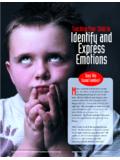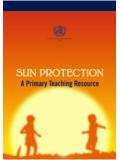Transcription of 101 WA YS TO TEACH CHILDRE N SOCIAL SKILL S
1 101 WAYS. TO TEACH children . SOCIAL SKILLS. A READY-TO-USE, REPRODUCIBLE ACTIVITY BOOK. by Lawrence E. Shapiro, ISBN10: 1-56688-725-9. ISBN 13: 978-1-56688-725-0. All rights reserved. Printed in the United States of America. 2004 Lawrence E. Shapiro The Bureau For At-Risk Youth grants limited permission for the copying of this publication for individual professional use. For any other use, no part of this book may be reproduced or transmitted in any form or by any means, electronic or mechanical, including photocopying, recording, or by any information storage and retrieval system, without written permission from the publisher. 1-800-99-YOUTH. A Brand of The Guidance Group 1-800-99-YOUTH. Product # 350809. 22061_Spreads 1/11/06 11:02 AM Page ii 22061_Spreads 1/11/06 11:02 AM Page iii TABLE OF CONTENTS.
2 Note: A reproducible worksheet follows each activity marked with an asterisk. INTRODUCTION ..VII. HOW TO USE THIS BOOK ..VIII. COMMUNICATING. Introduction ..1. 1. Something Special About Me ..2. 2. My Special Interests ..3. 3. My Values* ..4. 4. Introducing Yourself ..6. 5. Remembering Names* ..7. 6. Getting To Know Each Other ..9. 7. Getting To Know One Person* ..10. 8. We Have Something In Common* ..12. 9. Giving A Compliment ..14. 10. Accepting A Compliment ..15. NONVERBAL COMMUNICATION. Introduction ..17. 11. Tone Of Voice ..18. 12. Voice Volume* ..19. 13. Making Eye Contact* ..21. 14. Facial Expressions* ..23. 15. Gestures* ..25. 16. Personal Space* ..27. 17. Use Of Touch* ..29. 18. Posture ..31. 19. Interpreting Body Language* ..32. 20. Identifying Emotions.
3 34. 21. How You Look ..35. iii 22061_Spreads 1/11/06 11:02 AM Page iv BEING PART OF A GROUP. Introduction ..37. 22. Joining A Group* ..38. 23. Meeting New People ..40. 24. Asking Questions* ..41. 25. Sharing ..43. 26. Cooperating ..44. 27. Following Rules ..45. 28. Making Decisions Together ..46. 29. Being A Good Sport ..47. 30. Fostering Group Identity ..48. 31. Accepting Differences* ..49. 32. My Role Model ..51. 33. True Friends* ..52. 34. Understanding Cliques ..54. EXPRESSING YOUR FEELINGS. Introduction ..55. 35. Identifying Feelings* ..56. 36. Talking About Your Feelings ..58. 37. I-Messages* ..59. 38. Empathy* ..61. 39. Mixed Emotions* ..63. 40. Self-Talk* ..65. 41. Self-Control ..67. 42. Dealing With Anger Toward Others* ..68. 43. Dealing With Another Person's Anger*.
4 70. 44. Handling Change* ..72. CARING ABOUT YOURSELF AND OTHERS. Introduction ..75. 45. Seeking Help From Adults* ..76. 46. Understanding The Impact Of Your Behavior On Others* ..78. 47. Understanding The Behavior Of Others ..80. iv 101 WAYS TO TEACH children SOCIAL SKILLS. 22061_Spreads 1/11/06 11:02 AM Page v 48. Caring About Others* ..81. 49. Showing Interest In Others* ..84. 50. Prosocial Behavior ..86. 51. Kindness* ..87. 52. Kindness Cards ..89. 53. Giving Advice ..90. 54. Responding To Positive Advice* ..91. 55. Being A Friend* ..93. 56. Borrowing ..95. 57. Respecting Others ..96. 58. Offering Help To Others* ..97. 59. Depending On Others* ..99. PROBLEM SOLVING. Introduction ..101. 60. Identifying Problem-Causing Behaviors* ..102. 61. Refocusing Your Attitude.
5 104. 62. Brainstorming ..105. 63. Finding Alternative Solutions* ..106. 64. Deciding On The Best Solution ..108. 65. Learning From Mistakes ..109. 66. Thinking Before Acting* ..110. 67. Making Wise Choices* ..112. 68. Accepting Consequences ..114. 69. Group Problem Solving* ..115. LISTENING: A TWO-WAY STREET. Introduction ..117. 70. Hearing Or Listening? ..118. 71. Listening During A Conversation* ..119. 72. Listening For Information ..121. 73. Following Instructions* ..122. 74. Reflective Listening ..124. 75. Active Listening* ..125. 76. Positive Feedback* ..127. A READY-TO-USE, REPRODUCIBLE ACTIVITY BOOK v 22061_Spreads 1/11/06 11:02 AM Page vi STANDING UP FOR YOURSELF. Introduction ..129. 77. Feeling Good About Yourself ..130. 78. Creating A Positive Attitude*.
6 131. 79. Sticking Up For Yourself ..133. 80. Pat Yourself On The Back* ..134. 81. Avoiding Fights ..136. 82. Being Bullied ..137. 83. Dealing With Teasing* ..138. 84. Identifying Stress ..140. 85. Group Pressure* ..141. 86. Learning To Say No ..143. 87. Releasing Anger Safely* ..144. 88. Rights And Responsibilities ..146. 89. Being Assertive* ..147. MANAGING CONFLICT. Introduction ..149. 90. What Is Conflict? ..150. 91. My Personal Conflicts ..151. 92. It Takes Two ..152. 93. Apologizing ..153. 94. Knowing When To Resolve Conflicts* ..154. 95. Resolving Conflicts Calmly ..156. 96. Compromising* ..157. 97. Win-Win Solutions* ..159. 98. Negotiating ..161. 99. Peer Mediation ..162. 100. Fair Fighting* ..163. 101. Positive And Negative Outcomes* ..165. SKILLS INDEX.
7 167. vi 101 WAYS TO TEACH children SOCIAL SKILLS. 22061_Spreads 1/11/06 11:02 AM Page vii Introduction Some children seem to be socially adept from birth, while others struggle with various challenges of SOCIAL acceptance. Some children make friends easily; others are loners. Some children have self-control, and others have quick tempers. Some are natural leaders, while others are withdrawn. Many aspects of SOCIAL development seem to be an innate part of a child's temperament, but we also know that the environment can play an important part in shaping a child's SOCIAL development. In the last ten years, psychologists have become increasingly aware that SOCIAL skills can, and should, be taught. Many studies have shown that shy children can become more outgoing, aggressive children can learn self-control, and children who tend to be SOCIAL isolates can be taught how to make friends.
8 There is no question that children with better SOCIAL skills have a significant advantage in life. They not only experience the rewards of positive relationships, but they do better in school, have a better self-image, and in general, are much more resilient as they face life's inevitable challenges. This book is designed to TEACH SOCIAL skills to many different types of children , particularly those with SOCIAL problems. Often labeled as having a SOCIAL skills deficit, these children may be considered aggressive, socially isolated, or shy. The underlying concept is that to proceed through the expected stages of their SOCIAL development, children should posses all the skills addressed by this book. Written for use by groups of children , such as a classroom or a counseling group, the activities are intended to help children in every aspect of their SOCIAL development, as they relate their peers, their parents and their teachers.
9 While many activities can be used with just one child, it is hard to argue with the concept that SOCIAL skills are best learned in a SOCIAL environment. A READY-TO-USE, REPRODUCIBLE ACTIVITY BOOK vii 22061_Spreads 1/11/06 11:02 AM Page viii How To Use This Book This book is divided into nine sections that comprise the major categories of SOCIAL development. It can be used as the basis of a SOCIAL skills curriculum, or as part of an educational or treatment plan to address specific SOCIAL skills problems. Approximately half of the activities, identified by an asterisk in the Table of Contents, include reproducible worksheets. These worksheets can be photocopied directly from the book, or they can be printed from the accompanying CD. The worksheets on the CD are in PDF format, and you will need Adobe Acrobat Reader to view and print them.
10 This program can be downloaded without charge from viii 101 WAYS TO TEACH children SOCIAL SKILLS. 22061_Spreads 1/11/06 11:02 AM Page 1. Communicating Effective communication, the foundation of SOCIAL success, consists of many distinct skills. The activities in this section will help children communicate who they are to others and learn the skills that are so important in forming friendships. SOCIAL communication is a language and children are born with differences in their ability to learn this language, just as they have other learning differences. But there is no question that, with practice and encouragement, effective communication can be taught. This section begins by helping children understand and express what makes them unique. As children learn to convey their interests, their values, and even their problems, they increase their self-acceptance and self- confidence.








